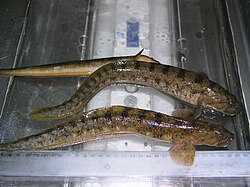Zoarces viviparus
| Viviparous eelpout | |
|---|---|
 |
|
| Scientific classification | |
| Kingdom: | Animalia |
| Phylum: | Chordata |
| Class: | Actinopterygii |
| Order: | Perciformes |
| Family: | Zoarcidae |
| Genus: | Zoarces |
| Species: | Z. viviparus |
| Binomial name | |
|
Zoarces viviparus (Linnaeus, 1758) |
|
The viviparous eelpout (Zoarces viviparus), also known as the, viviparous blenny and European eelpout is an eelpout in the family Zoarcidae. It is notable for giving birth to live larvae (hence the description "mother of eels"). It is a common soup ingredient in Mediterranean countries. The bones are of greenish colour, due to a harmless pigment. Their skin is slimy and the color is variable.
Viviparous eelpouts grow to a maximum length of 52 centimetres (20 in) and a maximum weight of 510 grams (18 oz). They typically live at water depths up to 40 metres (130 ft). The fish live to a maximum age of 10 years.
The viviparous eelpout has a slim, tapering body and resembles a small burbot (Lota lota), a wide head and mouth and protuberant lips. It has long, ribbon-like dorsal and anal fins which continue on to unite with the arrowhead-shaped caudal fin. This distinguishes this fish from the two similar slim-bodied bottom-dwelling fish of the area, the rock gunnel (Pholis gunnellus) and the snake blenny (Ophidion barbatum). The average size of this fish is about 20 to 30 cm (7.9 to 11.8 in). It is a brownish color with irregular dark brown markings and a yellowish belly. The pectoral, anal and caudal fins are tinged with orange which becomes a more intense hue during the breeding season. The bones are green.
These eelpouts live in a temperate climate in the marine waters of the Northeast Atlantic including the seas such as the Baltic, Barents, Irish, North, and White Seas. They also live in some brackish inlets, such where the River Somme meets the English Channel. The fish stay towards the rocky shorelines and tidepools among the stones and algae. The fish are capable of living out of water under rocks and seaweed due to their ability to breathe air directly. The fish eat eggs and of fish and macroinvertebrates such as gastropods and crustaceans.
...
Wikipedia
